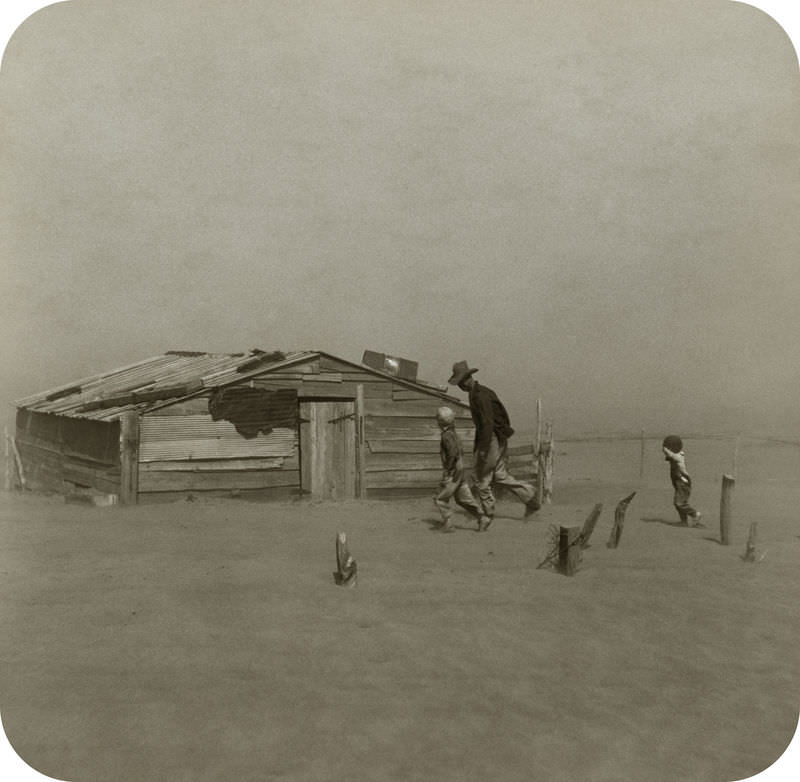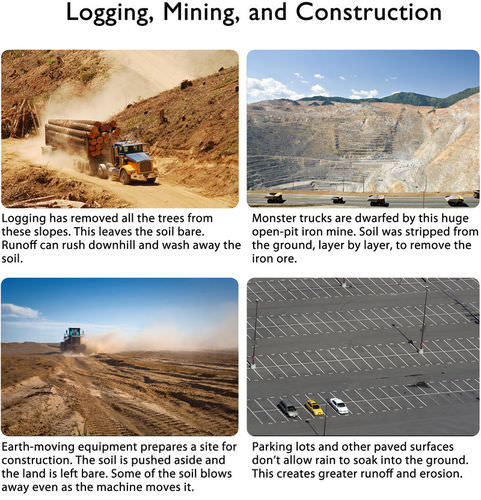13.10: Soil Erosion
- Page ID
- 5559
\( \newcommand{\vecs}[1]{\overset { \scriptstyle \rightharpoonup} {\mathbf{#1}} } \)
\( \newcommand{\vecd}[1]{\overset{-\!-\!\rightharpoonup}{\vphantom{a}\smash {#1}}} \)
\( \newcommand{\id}{\mathrm{id}}\) \( \newcommand{\Span}{\mathrm{span}}\)
( \newcommand{\kernel}{\mathrm{null}\,}\) \( \newcommand{\range}{\mathrm{range}\,}\)
\( \newcommand{\RealPart}{\mathrm{Re}}\) \( \newcommand{\ImaginaryPart}{\mathrm{Im}}\)
\( \newcommand{\Argument}{\mathrm{Arg}}\) \( \newcommand{\norm}[1]{\| #1 \|}\)
\( \newcommand{\inner}[2]{\langle #1, #2 \rangle}\)
\( \newcommand{\Span}{\mathrm{span}}\)
\( \newcommand{\id}{\mathrm{id}}\)
\( \newcommand{\Span}{\mathrm{span}}\)
\( \newcommand{\kernel}{\mathrm{null}\,}\)
\( \newcommand{\range}{\mathrm{range}\,}\)
\( \newcommand{\RealPart}{\mathrm{Re}}\)
\( \newcommand{\ImaginaryPart}{\mathrm{Im}}\)
\( \newcommand{\Argument}{\mathrm{Arg}}\)
\( \newcommand{\norm}[1]{\| #1 \|}\)
\( \newcommand{\inner}[2]{\langle #1, #2 \rangle}\)
\( \newcommand{\Span}{\mathrm{span}}\) \( \newcommand{\AA}{\unicode[.8,0]{x212B}}\)
\( \newcommand{\vectorA}[1]{\vec{#1}} % arrow\)
\( \newcommand{\vectorAt}[1]{\vec{\text{#1}}} % arrow\)
\( \newcommand{\vectorB}[1]{\overset { \scriptstyle \rightharpoonup} {\mathbf{#1}} } \)
\( \newcommand{\vectorC}[1]{\textbf{#1}} \)
\( \newcommand{\vectorD}[1]{\overrightarrow{#1}} \)
\( \newcommand{\vectorDt}[1]{\overrightarrow{\text{#1}}} \)
\( \newcommand{\vectE}[1]{\overset{-\!-\!\rightharpoonup}{\vphantom{a}\smash{\mathbf {#1}}}} \)
\( \newcommand{\vecs}[1]{\overset { \scriptstyle \rightharpoonup} {\mathbf{#1}} } \)
\( \newcommand{\vecd}[1]{\overset{-\!-\!\rightharpoonup}{\vphantom{a}\smash {#1}}} \)
\(\newcommand{\avec}{\mathbf a}\) \(\newcommand{\bvec}{\mathbf b}\) \(\newcommand{\cvec}{\mathbf c}\) \(\newcommand{\dvec}{\mathbf d}\) \(\newcommand{\dtil}{\widetilde{\mathbf d}}\) \(\newcommand{\evec}{\mathbf e}\) \(\newcommand{\fvec}{\mathbf f}\) \(\newcommand{\nvec}{\mathbf n}\) \(\newcommand{\pvec}{\mathbf p}\) \(\newcommand{\qvec}{\mathbf q}\) \(\newcommand{\svec}{\mathbf s}\) \(\newcommand{\tvec}{\mathbf t}\) \(\newcommand{\uvec}{\mathbf u}\) \(\newcommand{\vvec}{\mathbf v}\) \(\newcommand{\wvec}{\mathbf w}\) \(\newcommand{\xvec}{\mathbf x}\) \(\newcommand{\yvec}{\mathbf y}\) \(\newcommand{\zvec}{\mathbf z}\) \(\newcommand{\rvec}{\mathbf r}\) \(\newcommand{\mvec}{\mathbf m}\) \(\newcommand{\zerovec}{\mathbf 0}\) \(\newcommand{\onevec}{\mathbf 1}\) \(\newcommand{\real}{\mathbb R}\) \(\newcommand{\twovec}[2]{\left[\begin{array}{r}#1 \\ #2 \end{array}\right]}\) \(\newcommand{\ctwovec}[2]{\left[\begin{array}{c}#1 \\ #2 \end{array}\right]}\) \(\newcommand{\threevec}[3]{\left[\begin{array}{r}#1 \\ #2 \\ #3 \end{array}\right]}\) \(\newcommand{\cthreevec}[3]{\left[\begin{array}{c}#1 \\ #2 \\ #3 \end{array}\right]}\) \(\newcommand{\fourvec}[4]{\left[\begin{array}{r}#1 \\ #2 \\ #3 \\ #4 \end{array}\right]}\) \(\newcommand{\cfourvec}[4]{\left[\begin{array}{c}#1 \\ #2 \\ #3 \\ #4 \end{array}\right]}\) \(\newcommand{\fivevec}[5]{\left[\begin{array}{r}#1 \\ #2 \\ #3 \\ #4 \\ #5 \\ \end{array}\right]}\) \(\newcommand{\cfivevec}[5]{\left[\begin{array}{c}#1 \\ #2 \\ #3 \\ #4 \\ #5 \\ \end{array}\right]}\) \(\newcommand{\mattwo}[4]{\left[\begin{array}{rr}#1 \amp #2 \\ #3 \amp #4 \\ \end{array}\right]}\) \(\newcommand{\laspan}[1]{\text{Span}\{#1\}}\) \(\newcommand{\bcal}{\cal B}\) \(\newcommand{\ccal}{\cal C}\) \(\newcommand{\scal}{\cal S}\) \(\newcommand{\wcal}{\cal W}\) \(\newcommand{\ecal}{\cal E}\) \(\newcommand{\coords}[2]{\left\{#1\right\}_{#2}}\) \(\newcommand{\gray}[1]{\color{gray}{#1}}\) \(\newcommand{\lgray}[1]{\color{lightgray}{#1}}\) \(\newcommand{\rank}{\operatorname{rank}}\) \(\newcommand{\row}{\text{Row}}\) \(\newcommand{\col}{\text{Col}}\) \(\renewcommand{\row}{\text{Row}}\) \(\newcommand{\nul}{\text{Nul}}\) \(\newcommand{\var}{\text{Var}}\) \(\newcommand{\corr}{\text{corr}}\) \(\newcommand{\len}[1]{\left|#1\right|}\) \(\newcommand{\bbar}{\overline{\bvec}}\) \(\newcommand{\bhat}{\widehat{\bvec}}\) \(\newcommand{\bperp}{\bvec^\perp}\) \(\newcommand{\xhat}{\widehat{\xvec}}\) \(\newcommand{\vhat}{\widehat{\vvec}}\) \(\newcommand{\uhat}{\widehat{\uvec}}\) \(\newcommand{\what}{\widehat{\wvec}}\) \(\newcommand{\Sighat}{\widehat{\Sigma}}\) \(\newcommand{\lt}{<}\) \(\newcommand{\gt}{>}\) \(\newcommand{\amp}{&}\) \(\definecolor{fillinmathshade}{gray}{0.9}\)Could it happen again?
Farmers were forced off their lands during the Dust Bowl in the 1930s. The rains stopped, and the topsoil blew off these former grasslands. This scene was repeated throughout the central United States. During long droughts, some people wonder if another dust bowl could come.
Causes of Soil Erosion
The same agents that erode landscapes also erode soil. They are water, wind, ice, or gravity. Running water is the leading cause of soil erosion. Water is abundant and has a lot of power. Wind is also a leading cause of soil erosion. Wind can pick up soil and blow it far away.
Activities that remove vegetation, disturb the ground, or allow the ground to dry are activities that increase erosion. What are some human activities that increase soil erosion?
Farming
The photos below (Figure below) show how farming practices can increase soil erosion. Plant roots penetrate the soil and keep it from eroding. Plowing turns over bare soil and cuts through plant roots. Bare soil is exposed to wind and water. In the past, farmers always plowed fields before planting.
The problem doesn’t stop with plowing. Crops are usually planted in rows with bare soil in between the rows. In places where crops grow only during part of the year, the land may be bare for a few months.
Farming leaves some soil exposed to erosion.
The soil that is most likely to erode is the nutrient-rich topsoil. The loss of topsoil degrades the farmland.
Grazing
As pictured below (Figure below), some grazing animals, especially sheep and goats, eat grass right down to the roots. They may even pull the grass entirely out of the ground. Grazing animals can kill the grass. They may thin it out so much that it offers little protection to the soil. If animals are kept in the same place too long, the soil may become completely bare. The bare soil is easily eroded by wind and water.
Sheep and goats can damage plants and leave the soil bare.
Logging, Mining, and Construction
Other human actions that put soil at risk include logging, mining, and construction. You can see examples of each below (Figure below).
- When forests are cut down, the soil is suddenly exposed to wind and rain. Without trees, there is no leaf litter to cover the ground and protect the soil. When leaf litter decays, it adds humus and nutrients to the soil.
- Mining and construction strip soil off the ground and leave the land bare.
- Paved roads and parking lots prevent rainwater from soaking into the ground. This increases runoff and the potential for soil erosion.
Logging, mining, construction, and paving surfaces are some of the ways that soil erosion increases.
Recreation
Even things that people do for fun can expose soil to erosion. For example, overuse of hiking trails can leave bare patches of soil. Off-road vehicles cause even more damage; examples of this are pictured below (Figure below).
What’s fun for people may be bad for soil. Off-road vehicles can destroy plants and leave the ground bare. This sets up the soil for erosion.
Soil erosion is a natural occurrence. However, human activities have greatly accelerated soil erosion. In some locations, soil may now be eroding about 10 times faster than its natural rate. Since Europeans settled in the United States, approximately one-third of the topsoil has eroded away.
Summary
- Soil erosion is a natural process, but human activities can increase it.
- The main agents of soil erosion are water and wind.
- Soil erosion is more likely where the ground has been disturbed. Farming, grazing animals, logging, mining, construction, and recreational activities can do this.
Review
- What are the agents of soil erosion?
- How does farming accelerate soil erosion?
- How does grazing accelerate soil erosion?
- What is common about the human activities that increase soil erosion, such as logging, hiking, or driving an off-road vehicle?
- What happens when the rate of soil erosion increases?
- Which layer of soil is usually lost?
Explore More
Use the resource below to answer the questions that follow.
- Why was the steel plow important?
- What was needed during World War I?
- Why was the soil of this region particularly vulnerable to erosion?
- What had occurred by 1929?
- What happened in 1930? What was the problem with replacing prairie grasses with crops?
- What was a black blizzard?
- How could the Dust Bowl have been prevented?
- How has this region survived more recent droughts? Think about other sections you've studied, what might another reason be?






